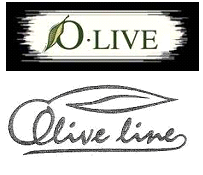Het beschrijvend concept olijf
Gerecht EU 22 mei 2012, zaak T-273/10 (Olive Line International tegen OHIM/Umbria Olii International)
 Gemeenschapsmerkenrecht. In de oppositieprocedure komt de aanvrager van het beeldmerk O·LIVE (klasse 3, 44) houdster van het gemeenschapsbeeldmerk en idem Spaans woord- en beeldmerk Olive Line tegen. De oppositieafdeling wijst de oppositie af. Het beroep wordt verworpen. Middel: de kamer heeft ten onrechte geoordeeld dat er geen verwarringsgevaar bestaat.
Gemeenschapsmerkenrecht. In de oppositieprocedure komt de aanvrager van het beeldmerk O·LIVE (klasse 3, 44) houdster van het gemeenschapsbeeldmerk en idem Spaans woord- en beeldmerk Olive Line tegen. De oppositieafdeling wijst de oppositie af. Het beroep wordt verworpen. Middel: de kamer heeft ten onrechte geoordeeld dat er geen verwarringsgevaar bestaat.
Het Gerecht EU oordeelt dat betreft klasse 3 (bleekmiddelen, oliën, tandpasta) en een deel van klasse 44, de beslissing van de kamer van beroep wordt vernietigd. Het is wel aannemelijk dat er sprake is van een verwarringsgevaar tussen de conflicterende merken. "the Board of Appeal made an error in taking the view that, since those concepts were descriptive in relation to the products in question, they could not contribute to any relevant conceptual similarity between the marks at issue."
67 However, it must be held that the Board of Appeal made an error in taking the view that, since those concepts were descriptive in relation to the products in question, they could not contribute to any relevant conceptual similarity between the marks at issue. The weak distinctive character of the word element ‘olive’ in relation to those products cannot call into question the conclusion that there are similar concepts creating a certain link between the marks at issue, given that, as pointed out in paragraphs 58 to 62 above, that element is the one remembered by the public faced with the trade mark applied for and constitutes one of the two elements of equivalent distinctive force in the earlier word mark. Moreover, in line with the finding of the Board of Appeal in paragraph 34 of the contested decision, it must be held that the second element present in the earlier mark does not bear an autonomous conceptual meaning differentiating it from the trade mark applied for.
68 It follows that, contrary to the assessment of the Board of Appeal, the marks in question are similar from a conceptual point of view.
Conclusie
80 Having regard to all the foregoing considerations, it must be concluded that the Board of Appeal erred in law in taking the view that there was no likelihood of confusion between the conflicting marks, within the meaning of Article 8(1)(b) of Regulation No 207/2009, for the goods and services covered by the trade mark application which are identical or similar to the goods designated by the earlier word mark. Accordingly, to that extent, the applicant’s complaint of the likelihood of confusion between the trade mark applied for and the earlier word mark must be upheld.
81 It follows that the contested decision must be annulled, first, in so far as it concerns the ‘soaps, perfumery, essential oils, cosmetics, hair lotions, dentifrices’ in Class 3 covered by the trade mark application, which are the same as the goods protected by the earlier word mark.
82 Second, the contested decision must be annulled in relation to ‘hygiene and beauty care for humans and animals’ in Class 44 covered by the trade mark application, which are similar to the goods protected by the earlier word mark.
83 Third, the contested decision must also be annulled in so far as it concerns ‘[b]leaching preparations and other substances for laundry use, cleaning, polishing, scouring and abrasive preparations’ in Class 3 covered by the trade mark application. Even taking account of the merely ‘marginal’ similarity of those goods with the goods protected by the earlier marks, in particular, ‘soaps’, as found by the Board of Appeal in paragraph 19 of the contested decision, the fact remains that the degree of overall similarity between the marks at issue is such that a likelihood of confusion between them cannot be ruled out despite the weak similarity of the goods. In that regard, it must be recalled that, according to settled case-law, a lesser degree of similarity between the goods or services designated may be offset by a greater degree of similarity between the marks (see O-live, paragraph 56, paragraph 100 and the case-law cited).
























